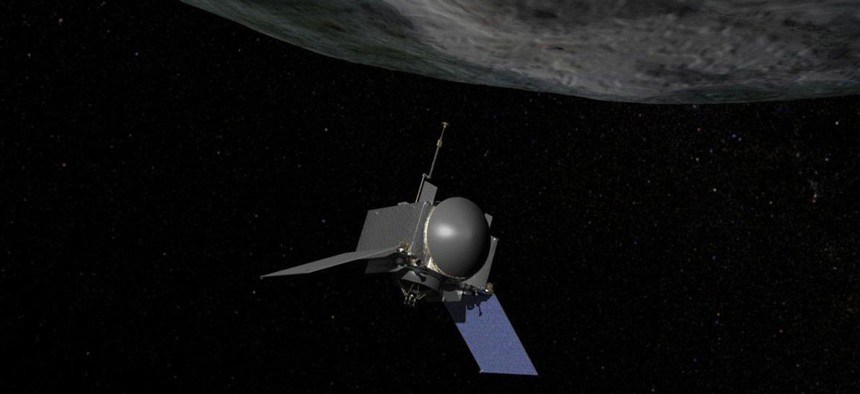
NASA/Goddard/Chris Meaney
NASA is Putting Your Artwork on an Asteroid
Astronomers believe there's a "high probability" that the asteroid collides with Earth in 2182, but dont worry—the art gallery will be orbiting the sun by then.
Mankind’s artistic expression is too beautiful to be confined to our home planet. To that end, NASA is putting an art gallery on 101955 Bennu. No, that’s not the bizarre name of a Brooklyn warehouse. It’s an asteroid.
As part of its “We the Explorers” campaign, the US space agency is taking digital art submissions to put onto a chip that will travel inside of a space probe and touch down on the surface of Bennu. The spacecraft, OSIRIS-REx, will launch in September and take two years to get there. In 2019, it’ll take a sample from the asteroid, becoming the first space probe in history to do so. During its brief stay on Bennu, any life forms can take in the traveling art exhibit, should they wish.
On its return home in 2023, the spacecraft will jettison the sample capsule, so it can fall back down to Earth for scientists to study. The remainder of the spacecraft, including the digital art gallery, will move into orbit around the sun where it’ll remain until the end of time or until aliens find it—whichever comes first.
“Space exploration is an inherently creative activity,” said Dante Lauretta, principal investigator for OSIRIS-REx, in a NASA press release. “We are inviting the world to join us on this great adventure by placing their art work on the OSIRIS-REx spacecraft, where it will stay in space for millennia.”
The theme of the space gallery is “what it means to be an explorer.” Artists around the world can send their paintings, poems, songs, or videos to the OSIRIS-REx Twitter or Instagram accounts. The deadline to submit is March 20.
It might seem silly, or even pointless, to send an art gallery into space, just because. But the initiative gets a lot more people interested in NASA and its missions, and OSIRIS-REx sounds like an important one. Researchers are hoping the sample from Bennu will contain organic molecules like amino acids, which can tell us a lot about how life begins and the likelihood that life exists elsewhere in the solar system.
Bennu, which is 492 meters in diameter, passed within just 35,400 kilometers (22,000 miles) of Earth in 2013—that’s less than a tenth of the distance from here to the moon. Astronomers believe there’s a high probability that it will collide with Earth in 2182. Still, “high probability” for an asteroid is still, generally speaking, a low probability. Right now, there’s roughly a 1 in 2,700 chance that Bennu hits us in the 22nd century.
Potential armageddon aside, this is just the latest initiative in a long line of NASA sending your stuff to space. NASA famously sent a number of images, sounds, and songs—from a variety of languages and cultures—with the Voyager spacecraft in 1977. In 2010, the space agency sent thousands of faces aboard the final two flights of the space shuttle. And in 2014, the it sent thousands of names on a microchip aboard the Orion spacecraft’s inaugural flight. NASA also sent a copy of the script to The Martian on that flight.






